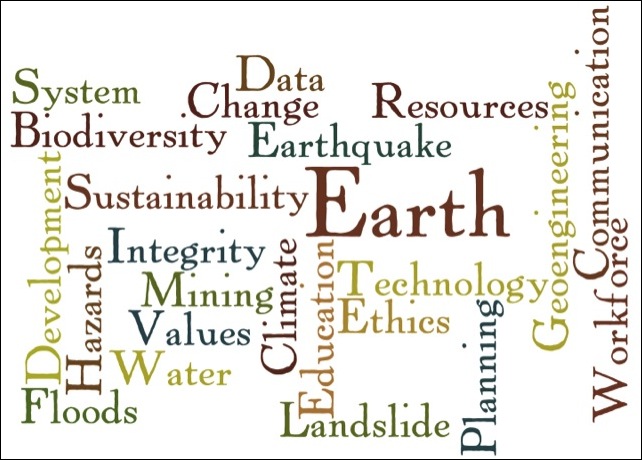 |
| Credit: Hongkai Gao (via imaggeo.egu.eu (i)) |
All humans are engineers, even the artists. Our close environment, the landscapes surrounding us are created by mankind. Intentional and unintentionally we do engineer the surface of the globe. We changed the surface, now we shift the climate. Threatened by climate change, shouldn't we endeavour to engineer the Earth to counter unintended climate change?
If all nine billion people of the globe would live like European citizens – or people in North America, Australia, Japon… – that would blow up the globe. Up-scaling advanced production and consumption patterns by a factor 20 is non-sustainable, and its down-scaling does not look feasible. Keeping current global imbalances of wealth and poverty does not seem fair. Striving towards “global sustainability” would require to adjust most of the the current production and consumption patterns. Without such adjustments, whatever these adjustments may be in detail, it seems unlikely to limit climate change to moderate scenarios of temperature increase and sea-level rise.
Evidently, human pressure on global systems is immense; unintentional terraforming is taken place going well beyond replacing pristine wilderness by rural landscapes. Humans change the state of the planet:
 |
| Dust Storm (Credit: Xuegang Mao (via imaggeo.egu.eu) |
State of Planet Declaration: “Research demonstrates that the continued functioning of the Earth system as it has supported the welfare of human civilization in recent centuries is at risk. Without action, we could face threats to water, food, biodiversity and other critical supplies: these threats risk intensifying economic, ecological and social crises, creating the potential for a humanitarian emergency on a global scale.
In one human lifetime, an increasingly interconnected and interdependent economic, social, cultural and political systems have come to place. These systems put pressures on the environment that may cause fundamental changes in the Earth system and move us beyond safe natural boundaries. However the same interconnectedness provides the potential for solutions: new ideas can develop and propagate quickly, creating the momentum for the significant transformation required for a truly sustainable planet.
The defining challenge of the modern era is to safeguard Earth's natural processes to ensure the welfare of civilization while eradicating poverty, reducing conflict over resources, and supporting human and ecosystem health.
As consumption accelerates everywhere and world population rise, it is no longer sufficient to work towards a distant ideal of sustainable development. Global sustainability must become a foundation of society. It can and must be part of the bedrock of nation states and the fabric of societies.” [a]
Contrary to a negotiated approach towards global sustainability, “geoengineering” is understood to deploy a “technology fix” for the same purpose, namely to limit climate change, leaving current production and consumption patterns unchanged.
Four scenes on engineering
 |
| Jan Mayen island- Credit: Sophie Tran (via imaggeo.egu.eu) |
Imagine! Your are on an intercontinental flight. The flight is well packed. It is warm in the cabin, too warm, and not really comfortable. The crew announces that the cooling system should be re-engineered in-flight because it is insufficient for the high number of passengers on the flight. You learn that preparatory work will start soon, that the Oxford principles [b] have been respected and that so experiments would be undertaken soon. How would you respond?
Recall and imagine! Oil-based fossil-energy-age is halfway; the moment of peak oil is close. The planet is well packed with people. It is getting warmer. It is not comfortable. The chef-scientists of the G8 consider that geoengineering should fix that by providing additional cooling for the planet. You learn that preparatory work will start soon with some experiments. How would you respond?
 |
| SPICE -experiment (ii) |
addressing of patenting. Would you support that?
Recently the science journal “Nature” reported that injection of volcanic ash into the troposphere was planned to happen some days after publication of the article [2]. Ash-particles in the stratosphere modulate global temperature; for example, seasonal temperature dropped after massive volcanic eruptions, which injected ash into the stratosphere. Injection of 50 barrels of volcanic ash into the atmosphere at 3000 and 4000 meters altitude off the west coast of France should test an aircraft sensor for volcanic ash-hazards. It was planned to fly through “the largest artificial ash cloud ever made”. The experiment was not reported to have had an environmental impact. The experiment was not cancelled because governance of geoengineering experiments is lacking.... Would you support that?
Pieces of a puzzle
Considering the current state of moderating climate change, human capability to reduce its overall pressure on global systems seems to be limited, even if consumption of top-consumers is capped. On the contrary, human consumption of resources and pressure on global systems likely will increase as people of developing countries arise from poverty. Most people of the globe are living at relatively low levels of consumption. Their level of consumption will increase to get a fair share of the global resources; whatever fair may mean once someone does not live in poverty.
Their experiences made Humans much inclined to look for technological fixes for problems because that is what experiences taught. This approach, technological fixes had worked in the past and is something in which humans are good at. On the other side, the design and rolling-out of sustainable ways of economic and social functioning are a fringe activity in industrialised societies; they are getting their publicity, but little more. The German “Energiewende”, the attempt to replace in a decade-long process fossil-energy by renewable energies are mainly a technological project. However, what is wrong in focusing human efforts on methods in which mankind is strong?
 |
| Source - Environmental Protection Agency (iii) |
So far, a combination of public awareness and political concern, of technological fixes and negotiated regulatory actions has been applied to limit threats to regional and global systems, which were caused by pressure of human production and consumption patterns. So far, none of these methods, which were put in place, neither the technological fixes nor the regulations had to put into question the consumption pattern of the modern industrialised societies. Also so far, these methods were enough to reduce pressure on global or regional systems by reducing inputs without impacting on current production and consumption patterns. Common to these methods was to reduce inputs into global or regional systems by withholding emission, replacing substances or limiting use cases for certain substances. Thus, in these cases the selected approach was a technological fix or regulatory measure targeting the “start of the pipe”. Mature solutions to environmental threats replace “end of pipe” approaches with “start of the pipe” solutions; handling sewage water being the most pertinent historical example. What are situations in which “start of the pipe” are less appealing?
Applying a “start of the pipe” approach to climate change faces the issue that mankind should reduce inputs
were its hurts, namely reducing radically energy that is produced from burning fossil fuels. Capping burning of fossil fuels would be disruptive for the economic structures or the consumption pattern of the developed and developing industrialised societies. In addition, the disruptive change should take place in a manner that is coordinated at the scale of the globe. This seems a recipe for a “mission impossible”. The pace of negotiations on climate change matters clearly shows this. On the other hand, the consequences of a run-away climate change and the price of business as usual scenario looks forbiddingly high, as well in economic as in social costs that likely will be caused by climate change. Facing that dilemma affordable geoengineering looks tempting for some. Mankind could build on its strength, avoids disruption of the economic structures or the consumption pattern. The immediate downside of doing geoengineering is the feeling to get “in-flight re-engineered”; notwithstanding that geoengineering methods would have to be tested, evaluated, agreed and regulated before being deployed. By whom?
 |
| Source: http://www.ncpa.org/pub/ba644 |
However geoengineering technologies, which counter climate change by other means than carbon capture at combustion, are of a different nature than the technological fixes and negotiated regulatory actions, which have been applied to limit threats to regional and global systems. Increasing the surface albedo to increase backscattering of sun-light, sheltering sun-light by aerosols or clouds in the higher atmosphere, capturing excess carbon by ocean fertilisation, afforestation etc.; all these technologies target other parts of the climate system but the carbon-dioxide input into the atmosphere. Therefore, many geoengineering technologies differ qualitatively because they do not tackle the initial cause, namely the carbon-dioxide inputs that are too high. Possibly, a technology that reduces inputs at the sources might gain more easily public support for its application. That may happen at least “in principle” and under the assumption that its cost is considered to be appropriate. Whatever appropriate may mean in a given situation, likely “appropriate” would mean that the cost would not be disruptive for the current economic structures or consumption patterns. Is that a pessimistic view?
 |
| Credits: http://www.attac-hellas.org/seminars/geoengineering/programmeenglish.htm |
So far for analogies; but what about developing and testing “technological fixes”, i.e. “stronger pumps”, as long as you have the opportunity to do so without being driven by an emergency situation? Would it be appropriate to develop in a regulated manner some affordable geoengineering technologies [3]?
Ukko El’Hob
Modified contribution to the blog of the International Association for the Promotion of Geoethics
[1] David Kramer, 2013 Geoengineering researchers ponder ethical and regulatory issues, Physics Today Vol. 66(11).
[2] Alexandra Witze 2013, Volcanic-ash sensor to take flight, Nature Vol. 502
[3] Adam Corner and Nick Pidgeon 2010, Geoengineering the climate: The social and ethical implications, Environment Vol. 52.
(i) This is a snapshot on the train from Lijiang to Kunming, Yunnan Provice in China. The terraced field is the creature of remaking nature, and the symbol of harmonous life style between human being and environment. No conquer, but live together.
(ii) Diagram of test. Click the image to view full size (53KB). Copyright Cambridge University Engineering Department. http://www.nerc.ac.uk/press/releases/2011/22-spice.asp
(iii) http://www.rpi.edu/dept/chem-eng/Biotech-Environ/Environmental/acidrain/kids.html
(ii) Diagram of test. Click the image to view full size (53KB). Copyright Cambridge University Engineering Department. http://www.nerc.ac.uk/press/releases/2011/22-spice.asp
(iii) http://www.rpi.edu/dept/chem-eng/Biotech-Environ/Environmental/acidrain/kids.html
[a] http://www.planetunderpressure2012.net/pdf/state_of_planet_declaration.pdf, “State of the Planet Declaration" adopted by the conference “Planet under Pressure” 26th -29th March 2012 in London.
[b] http://www.geoengineering.ox.ac.uk/oxford-principles/principles/ In December 2009, the Oxford principles, initially drafted by scholars were endorsed by the to UK House of Commons Science and Technology Select Committee on “The Regulation of Geoengineering” making them a national-level policy statement on responsibly executed geoengineering research.
[c] The injection height of 1.000m, following habitual definition, would be much below the stratosphere habitually having a lower limit around 10.000m. However, “SPICE” is not a mis-name of the project. The cancelled experiment was part of a much bigger undertaking that apparently run also into difficulties because of a dispute about patent rights for geoengineering techniques (see: D. Cressy 2012, Geoengineering experiment cancelled amid patent row, NATURE, Vol.(485) http://www.nature.com/news/cancelled-project-spurs-debate-over-geoengineering-patents-1.1069).


.jpg)


















